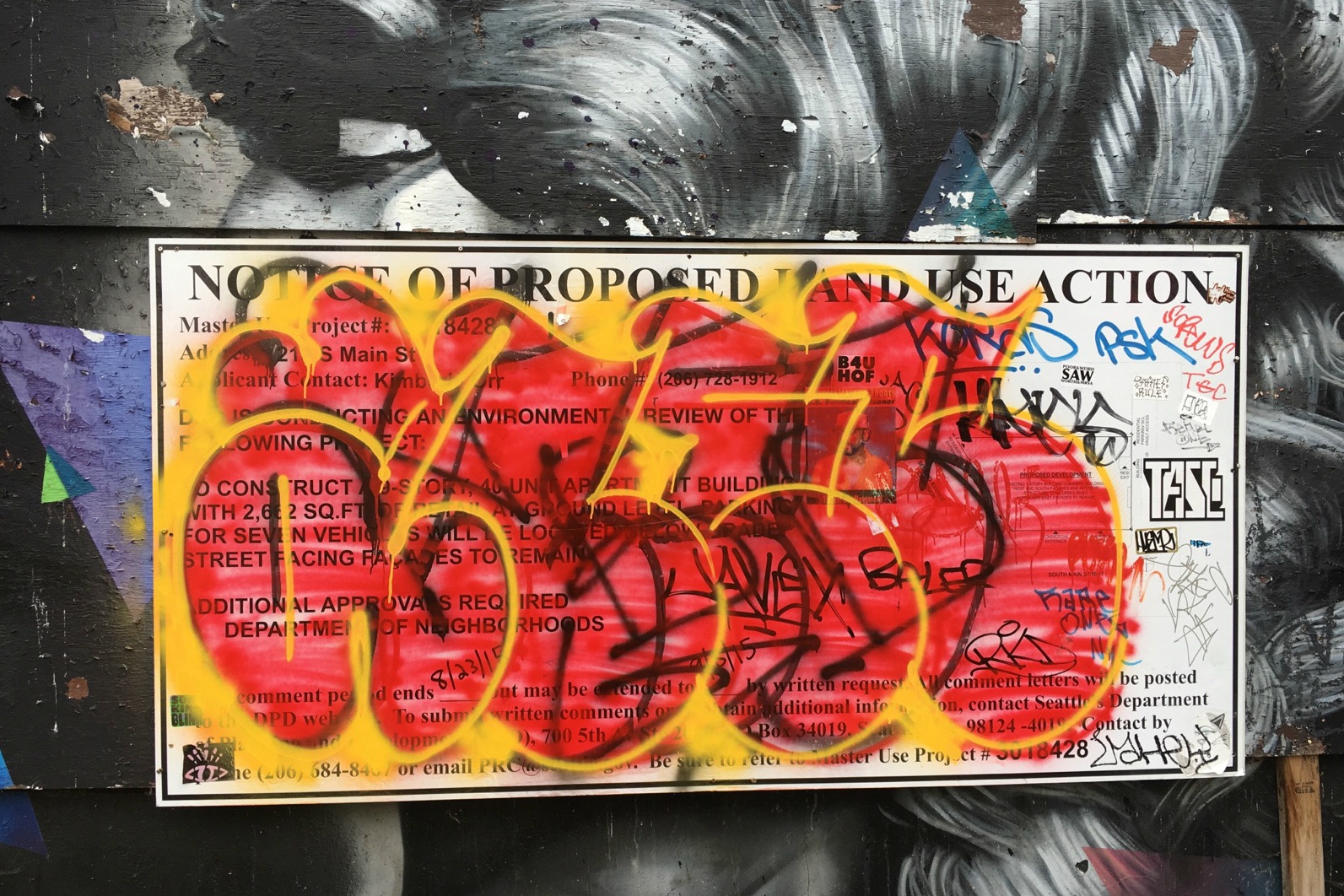The architecture of Urban Float Fremont—glassy, tiled, and angular—is very new-Seattle. With its Macs, iPads, and millennials, it looks like a Belltown condo, except somehow salubrious.
Floating is the practice of shutting yourself in a soundproof, lightproof tank and chilling out for an hour. The tanks are filled about knee-high with skin-temperature water super-saturated with Epsom salts. After disrobing and climbing in, you’re suspended in the solution—no sights, no sounds, no (physical) feeling. Proponents say sensory deprivation creates an ideal environment for spiritual and physical healing—“meditation for dummies,” a friend called it.
People in the business say Seattle has the most float centers per capita of any city in the U.S. A cursory search on Google Maps reveals nine from Tacoma to Everett. At up to $89 for a one-hour session, it is also a lucrative and rapidly expanding industry.
What has made floating so big, right here, right now? And what made this New Age vestibule the best place to achieve spiritual transcendence in Seattle?
Days earlier I’d met with Leo Church, business development manager for Urban Float, and asked him exactly this. At Urban Float, he told me, the focus is “exclusively on floating,” unlike some spas that just happen to have tanks; the tanks themselves, of the i-sopod brand, are “the most proven float tanks,” with “motors outside the tank, so the very most you’re going to hear is flowing water”; the ancillary gizmos include a “titanium flow-through heater, to ensure constant temperature, so you don’t get exposed to some kind of electromagnetic field . . . ”
“Electromagnetic field?” I say.
“People who are extremely into floating,” he says, “don’t want to be exposed to anything.”
Carmen, Urban Float’s receptionist, is one of these. “I floated before my shift,” she tells me. “The other day I had a really good float where the masculine and feminine were coming together. I felt it was a reflection of the way the Earth is going, and it literally just happened in front of my eyes.”
“Far out,” I say.
As Leo told me earlier, “Some folks experience floating from more of a psychedelic kind of place.” This is great, because I love psychedelics. My first trips on shrooms and acid, both in college, have been the best experiences of my life, and I make time for at least a microdose at least once a month. I was firmly convinced I had hallucinated the Seahawks’ NFC Championship victory last year—so if the masculine and feminine were coming together, far be it from me to judge.
Carmen leads me upstairs, to the pre- and post-float room, past a gallery of galaxy prints. She hands me an iPad and I watch a six-minute video.
“Disconnect from an overconnected world,” it exhorts me, as if I’m in an unplugging scene from The Matrix. The feminine voice, rich in ASMR and Britishness, continues: “Floating may seem like magic, but it is backed up by over 30 years of mainstream scientific research.” She murmurs on. Floating lowers blood pressure, lessens jet lag, boosts endorphin production . . . I hope it can help with my insomnia. I am feeling very, very sleepy.
I rouse myself, take a shower, and get inside the i-sopod.
It takes some time for me to get the settings right. I turn off the lights, which otherwise switch among mellow colorations at regular intervals. I poke out, put in earplugs, and get back in. Finally, I grab the headrest, and at last reach a blissful, deprived equilibrium.
I don’t have many thoughts as I float, but the ones that I do are memorable—it’s a little like being lulled into a dreamlike state, the subconscious bubbling up through the silenced noise of real life. I think about the troubles of my friends, alienated by the harsh and acquisitive new Seattle. I think about my tutoring business, which provides me with a living and some sense of purpose, but is hopelessly tied up in that new Seattle. I think about two quotes from Ulysses, in which someone calls the Dead Sea “the grey sunken cunt of the world” and someone else calls his penis his “limp father of thousands.” I think about jerking off and how that would alter the salt saturation, but in the tank, disgust outraces lust—for once.
Sometime during this reverie I begin to feel a jet poking my body toward the walls of the tank. I spend a while trying to turn it off.
“Christopher?”
The pod bay door opens a crack.
“Christopher,” says Carmen, prying open the i-sopod ever so modestly, like a Victorian bathing machine. “Your session is over!”
“It is?”
I emerge, shower again, and walk out. “How long was I in there for?”
“About 90 minutes.”
“Oh, shit. Was I supposed to get out when the jets came on?”
“Yep. We thought you fell asleep!”
“I don’t think so,” I say. “I thought I was supposed to get out when the music played.”
“There wasn’t any music?”
“Maybe I was asleep,” I say. “Or I’ve drowned and gone to heaven.”
Carmen looks alarmed. “Float tanks are perfectly safe,” she tells me, and I believe her.
I feel sluggish and relaxed—an amazing catnap, forsooth. I head to work, and for the first time in weeks, I enjoy tutoring one of my younger students. All kids act like they’re on acid, the younger the more so—and what are flotation tanks but fiberglass wombs, suspending you in amniotic fluid?
Yet my happiness feels delicate against the realities of traffic and greed, of daily life in today’s Seattle. The expense is far higher, the high more fugitive, than simply eating some stems of shrooms or taking a tab of acid. I get home late and pass out until 12:30 the next day—exactly what I’d wanted.
Leo and I are sitting in a coffeeshop on Beacon Hill; he’s ordered me a double-tall Americano, putting me in a decidedly unmeditative state.
“Floating is popular in Seattle for two reasons,” Leo is telling me. “The first is that we’re on the West Coast, and the West Coast is more open to practices like yoga and meditation. The second is that we have a large percentage of young people that have disposable income. If you’re spending $70, $80, $90, you’ve gotta have some money . . . but we look at it as an investment in yourself.”
Just thinking about South Lake Union and its well-paid techies makes me want to cleanse myself in Epsom-salt water—funny, as working in software is sensory deprivation on an institutional level.
“Corporate people are frequent customers,” Leo adds.
At floating’s inception, this would have been unthinkable.
The first tank was developed by John C. Lilly in the 1950s as a way for him to study conciousness. In the 1960s, Lilly’s contemporaries in the field of altered-state research, including Ram Dass and Timothy Leary, gained widespread recognition from their practices of spirituality and drug use. But floating remained unheard-of—“something where there’d be a tank in someone’s basement,” said Leo—until recently.
Urban Float owner Joe Beaudry describes the rapid expansion of floating in the region: “We have six pods in Renton and Kirkland, and three pods in Fremont. When we started, in 2011, there were no other float centers in the area, and I could count the number of legitimate float centers in the country on two hands. Now there are something like 350. How was your float?”
“It was OK.”
“Most people don’t settle into a good float like that their first time,” says Joe. “Usually it takes two or three visits.”
This is one way that floating has turned evangelism into a business model. By presenting itself as a “practice,” like yoga or Pilates, floating has both retained a devoted following and sold a lot of memberships. At Float Seattle (not to be confused with Urban Float), the commercial is even more obviously wedded to the revolutionary. A promotional video, titled “Get out of the rat race, open your own float tank business,” begins:
“Life is short. As a couple of disenchanted office workers about to hit 30, we decided to shake things up, leave the safety of a paycheck behind, and start a company with the intent of helping as many people as possible.”
Driving to Float Seattle’s Green Lake location, I think of Steve Jobs, who famously cited dropping acid as a major influence in the development of his aestheticized corporate juggernaut.
I arrive and chat with Aaron X. Harris, Float Seattle’s general manager.
“At my peak,” he tells me, “I floated 100 days in a row.”
“Far out,” I say.
“Exactly,” says Aaron. “Out-of-body experiences, astral projections, and lucid dreams all rank in my personal top-floating experiences.”
I book a session at Float Seattle for 5:30 p.m. on the day before Thanksgiving. To maximize its impact, I go to the bank, deposit some checks, and open a business account. The ATM eats some of my checks, and the representative has me drive to and from my apartment, in rush-hour traffic, to pick up a forgotten document. Miserable and stressed out, my plan is working perfectly.
I walk into Float Seattle at 5:37. The facility is less lavish than Urban Float, resembling the local pool in sight and smell. I like this.
Neal, a guru (all employees here are called gurus), leads me to my room. “This is the classic tank,” he says, “no light, no music.” I like this even more.
I get in and begin to breathe deeply. The tank is darker and quieter than Urban Float’s. Soon I have fallen asleep—except I am still awake. The moment where I pass over feels like an orgasm, a moment of illucidity, and the quality of my thoughts instantly changes. In everyday life, I try to think myself into happiness. But since first experiencing shrooms, I’ve known the reverse reaction was more powerful—which is why I love psychedelics. Inside the tank I empty my head, and briefly glimpse something clearer and purer.
Then time is up—too soon.
“How was it?” asks Neal.
“Much better than my first float.”
“That’s typical. We always say floating is a practice; it usually takes two or three visits . . . ”
I drive to the bar, meet some old friends, run into another, and feel much younger. The entire evening feels like living in a memory, as effortless and timeless as evolving in salt water.
“Did you find absolution?” asks one friend.
“No, just ablution.”
“I’d like to try floating,” he says.
“You should.”
Our companions, who work at a hospital, roll their eyes. Indeed, Leo, Joe, and Aaron all cited floating being “unheard-of” as its biggest impediment to growth.
That, and it’s damned expensive. Ten hours on acid costs me around $8; one hour in the tank is closer to $60. Of course, you could always combine the two . . .
We close out at the bar, and the bill is $40 per head.
As I head home, businesses are beginning to shut down early for the holiday. Not since Tom Robbins dropped acid in Wallingford has North Seattle been so placid. It’s as if floating has brought back the old Seattle, lazy and serene, that lives in my memory. Drunk and detoxified, I feel inoculated against the poisonous influences the long weekend will bring: drugs, alcohol, my paternal grandmother.
That night, I sleep so soundly I remember my dreams.
news@seattleweekly.com
CML, a freelancer in Seattle, has written for Gawker, The Daily Dot, and several other publications. He maintains a website at cmlwrites.com and a Twitter at @CMLisawesome.






